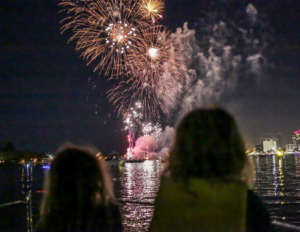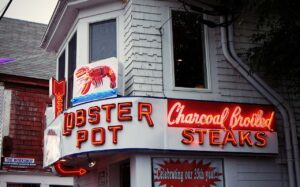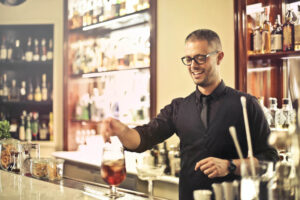
IN AUTUMN THE South truly shines. Temperatures wane. Action on the gridiron heats up. And before you know it, here come the holidays. As this issue of Marinalife looks southward, I thought it apropos to serve up stories and recipes about iconic southern cocktails indigenous to Southern shores. Two come from the great drinking city of New Orleans. Another is a punch, because we Southerners love an excuse to bring out a punch bowl! One is even associated with the South’s winningest college football team, which is where we shall begin.
The Alabama Slammer
This cocktail was born in the 1970s in a bar in Tuscaloosa, the home of the University of Alabama Crimson Tide football team. While Bama fans can recount all 15 national championships dating back to 1925, nobody seems to remember exactly what bar or which bartender first thought to combine Southern Comfort, sloe gin, Amaretto and orange juice in a glass. Some fans claim it might have been served originally as a shot to “slam back.”
However it came about, the sweet drink grew in popularity and peaked in 1988 when the movie “Cocktail” came out. In it, Tom Cruise’s character Brian the bartender calls it out while reciting a poem standing atop his bar in one of the movie’s most memorable scenes. The drink’s esteem has waned, however, as America’s cocktail palette keeps moving away from sweet cocktails. Nevertheless, loads of Alabama fans still consider it the signature cocktail of their beloved Crimson Tide.
If you want to give this drink another chance or even try your first, I suggest you belly up to the bar in any port between Mobile, AL, and Panama City, FL. Chances are you’ll find a bartender who will serve one up on the rocks, in a shot glass, or, heaven forbid, as a Jello shooter. Roll Tide!
The Hurricane
New Orleans is the home of our next cocktail, the Hurricane. It’s a sweet, fruity drink served in a distinctive tall curved hurricane glass, a take on the wind resistant lamps used by mariners in the 18th and 19th centuries to light ship cabins and decks and to send signals from ship to ship.
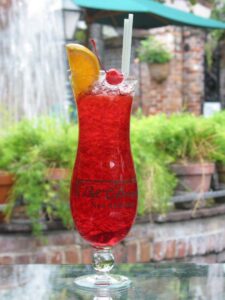
The Hurricane isn’t quite that old. It dates back to the 1940s when American distillers produced alcohol for the war effort. Popular spirits such as bourbon, scotch and gin were in short supply, so people turned to cheap, plentiful Caribbean rum to wet their whistle. Much of that rum was imported through New Orleans. Its flavor, however, didn’t jive with local tastes.
Enter bar owner Pat O’Brien, an Irishman who’d run a speakeasy during Prohibition. His solution was to create a cocktail to mask the flavor of the rum. O’Brien mixed golden rum with lemon juice and passion fruit juice, which gave the drink its signature sweetness and red color. He named it the Hurricane, ostensibly because he felt it looked best in a hurricane glass, but also perhaps as a nod to the old secret code to enter his Prohibition speakeasy, “storm’s brewing,” or maybe as a gesture to appease the hurricane gods?
The Hurricane today is New Orleans’ most popular cocktail. It seems every other inebriated soul on Bourbon Street carries one in a big plastic souvenir cup. I’d suggest, however, you order one in a classy joint. Be careful, though, because like a hurricane, it can leave a powerful hangover in its wake.
The Sazerac
Cocktail historians trace this drink back to early 19th century New Orleans and the days of French Creole culture when a druggist and freemason named Antoine Peychaud hosted meetings at his pharmacy and served a special mix of Sazerac de Forge Cognac, absinthe and his proprietary bitters. Several decades later, the crème de la crème of New Orleans society would gather at an establishment called the Sazerac House in the French Quarter to talk business and play cards. Serious matters required a serious drink, so patrons sipped a cocktail made of French brandy fortified with absinthe, an anise flavored spirit and Peychaud’s bitters. This house drink became known as the Sazerac.
A couple of global events subsequently gave rise to the modern Sazerac. First was the decimation of France’s grape industry by aphids in the late 19th century. As brandy imports dried up, bartenders at the Sazerac House turned to rye whiskey. In 1910, America joined European nations in banning absinthe for its supposed hallucinogenic effects. This was followed in 1920 by 13 years of Prohibition. When the “dry experiment” finally ended, a new anise flavored spirit called Herbsaint captured the fancy of New Orleans drinkers and soon became a staple in the modern 20th century Sazerac.
Today, the famous art deco Sazerac Bar in The Roosevelt Hotel New Orleans pays homage to the libation, often referred to as the world’s first cocktail. Of course, this is debatable, but it is fun to think it while you drink it. In April 2018, Louisiana legislators designated the Sazerac as New Orleans’ official cocktail.
Chatham Artillery Punch
Savannah, GA, another southern port city, is where we investigate our final cocktail, which is technically a punch, because it is mixed and served in a bowl meant for many to imbibe. Chatham Artillery Punch has been served since Colonial times. Georgia’s oldest military unit, the Chatham Artillery, originally mixed it up in large horse buckets and ladled it out at special celebrations. One story says Artillery members toasted George Washington with the punch as early as 1791. Nowadays it’s especially popular with locals during the holidays.
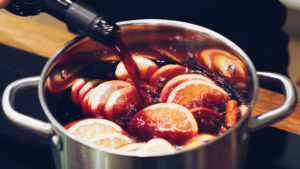
The Artillery has a distinguished past. The fighting unit served in the Revolutionary War, the War of 1812, the Civil War, WWI, WWII, and more recently in Afghanistan. It’s still around as part of the Georgia National Guard.
Over the years, many variations were made to the punch, but brandy, bourbon, champagne, rum and tea are still its main ingredients. And true to its name, it packs a punch. Admiral George Dewey got so drunk from Artillery Punch during a visit in 1900 that horrified journalists covering the trip felt compelled to label his ill condition the next day the result of a bad salad. It’s no wonder the locals describe the drink as “delirious deliciousness.”
I hope you enjoyed this cocktail journey along the southern coast. As for the boat-friendly nature of the drinks, you might not have a horse bucket or a punch bowl on board, but I bet there’s a big Igloo cooler around somewhere that’ll get the job done.
Cheers!


